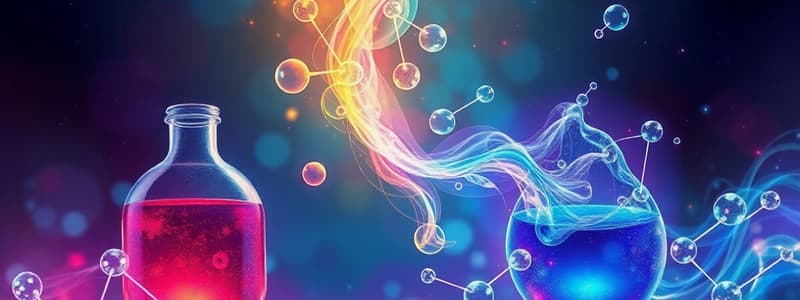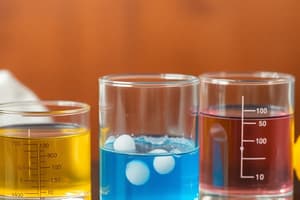Podcast
Questions and Answers
What is the primary product formed when an acid reacts with a base?
What is the primary product formed when an acid reacts with a base?
- Salt and carbon dioxide
- Salt and hydroxides
- Water and hydrogen gas
- Salt and water (correct)
Which of the following statements accurately describes alkalis?
Which of the following statements accurately describes alkalis?
- All bases are alkalis regardless of solubility
- Alkalis are insoluble bases in water
- Alkalis do not react with acids to form salts
- Alkalis dissolve in water to form alkaline solutions (correct)
In a neutralisation reaction, what ions combine to form water?
In a neutralisation reaction, what ions combine to form water?
- Hydroxide ions and oxygen ions
- Hydrogen ions and hydroxide ions (correct)
- Hydrogen ions and sodium ions
- Hydroxide ions and chloride ions
What is true about pure water regarding pH?
What is true about pure water regarding pH?
Which of the following substances is classified as a base?
Which of the following substances is classified as a base?
What type of base is zinc oxide, considering its properties?
What type of base is zinc oxide, considering its properties?
Which indicator can be used to determine the pH change during a neutralisation reaction?
Which indicator can be used to determine the pH change during a neutralisation reaction?
How do acids in solution behave in terms of ion release?
How do acids in solution behave in terms of ion release?
Flashcards
Base
Base
Any substance that reacts with an acid to produce a salt and water only. Metal oxides and metal hydroxides are bases.
Alkali
Alkali
A soluble base that dissolves in water to form an alkaline solution.
Neutralization
Neutralization
The reaction between an acid and a base, resulting in the formation of a salt and water.
Neutral Solution
Neutral Solution
Signup and view all the flashcards
Acid-alkali Neutralisation
Acid-alkali Neutralisation
Signup and view all the flashcards
pH Probe
pH Probe
Signup and view all the flashcards
Universal Indicator
Universal Indicator
Signup and view all the flashcards
pH Scale
pH Scale
Signup and view all the flashcards
Study Notes
Neutralisation Reactions
- Neutralisation is the reaction between an acid and a base.
- Bases react with acids to produce a salt and water.
- Metal oxides and metal hydroxides are bases.
- Bases that dissolve in water are called alkalis.
- Insoluble bases are not alkalis.
- Example: Copper oxide is a base but not an alkali. Sodium hydroxide is both a base and an alkali (as it dissolves).
- Alkalis are soluble bases.
- Not all bases are soluble in water, therefore not all bases are alkalis.
- Zinc oxide is a base, but it's insoluble in water, so it's not an alkali.
Acid-Base Neutralisation
- Acids in solution release hydrogen ions (H+).
- Alkalis in solution release hydroxide ions (OH-).
- In a neutralisation reaction, hydrogen ions (from the acid) react with hydroxide ions (from the alkali) to form water (H₂O).
- The reaction is: H⁺(aq) + OH⁻(aq) → H₂O(l)
- Neutral solutions have a pH of 7.
- The change in pH during neutralisation can be measured using a pH probe or estimated using universal indicator.
Studying That Suits You
Use AI to generate personalized quizzes and flashcards to suit your learning preferences.




